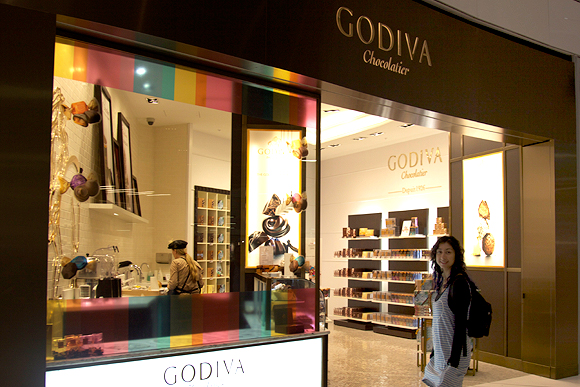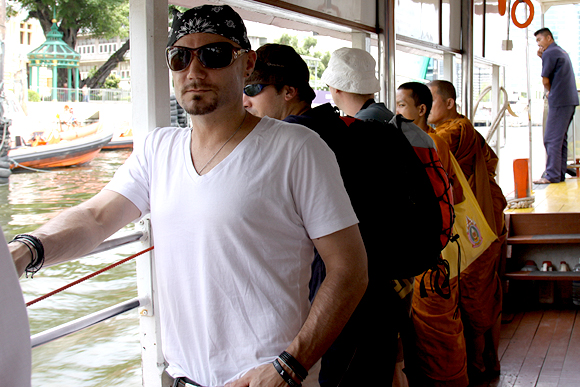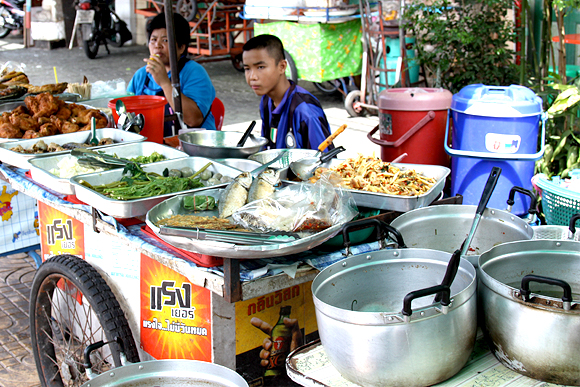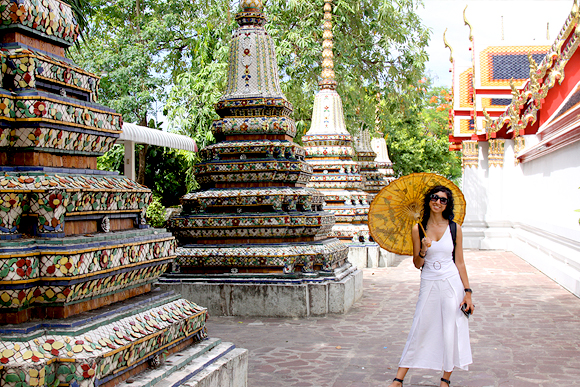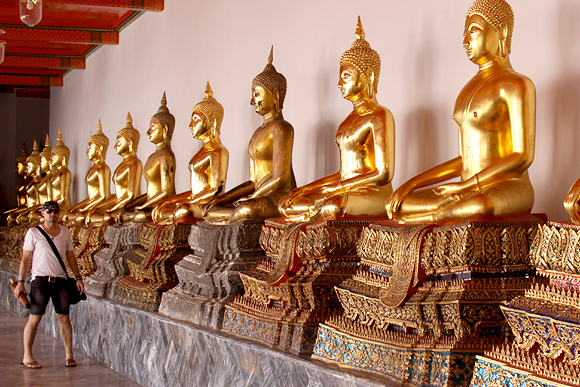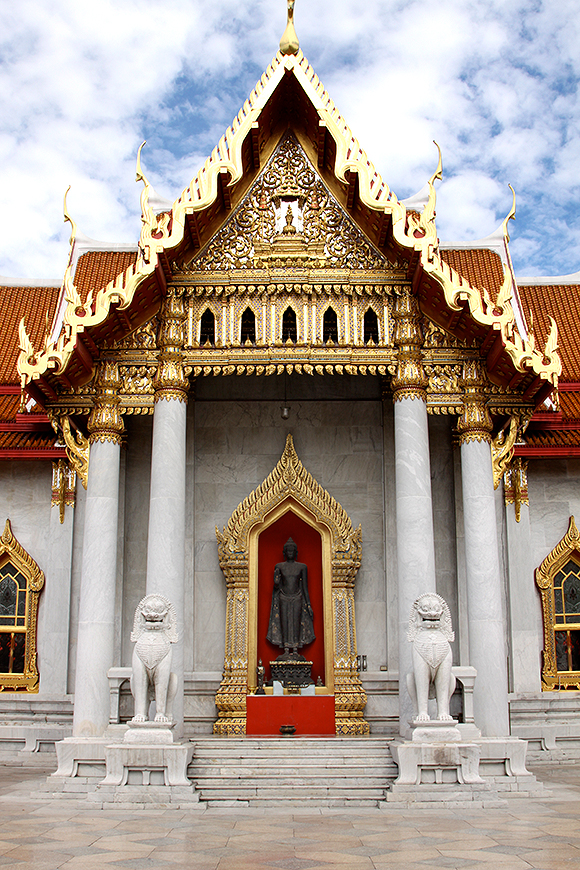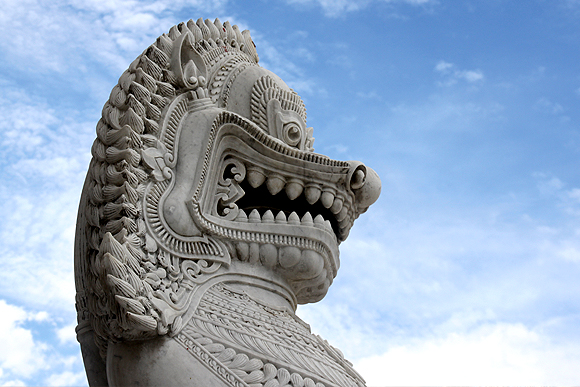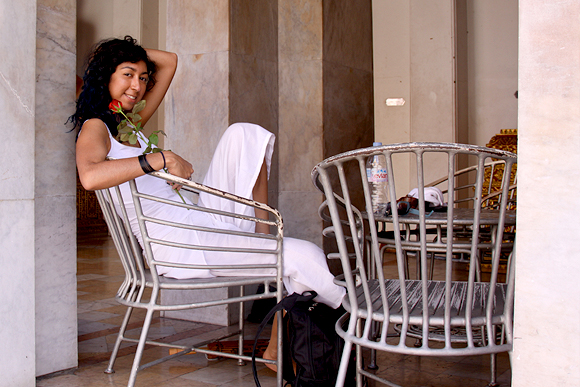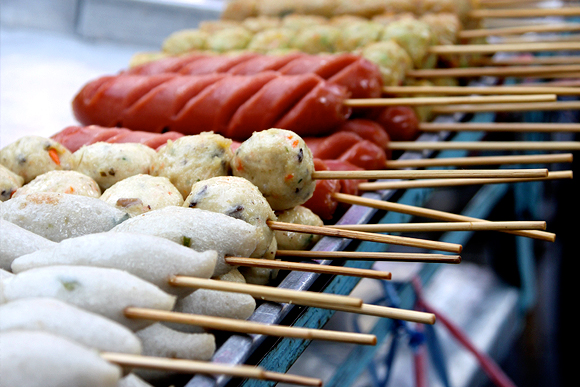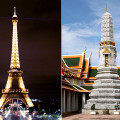It was May 21, 2010; the tail-end of what was three months of political unrest between the Thai government and the “Red Shirts”, also known as the Bangkok riots – and we had just landed in Bangkok.
Two days prior, the army had marched on the Red Shirt’s headquarters in central Bangkok, launching an all-out attack, destroying 35 buildings including the Stock Exchange, banks, shopping centres, a TV station, and a cinema. A “do not travel” notice was issued for Bangkok. All the hotels in the vicinity were shut, tourists evacuated, and barricades built around them. Our hotel was one of these.
We were notified of the closure via email, and I then spent the next day (the day before we left for Thailand) frantically organising alternate accommodation on the outskirts of the city. Call us crazy (many did!), but through the tears and stress and mania, we decided not to cancel our plans. Too much had gone into this trip. Work had reached a crescendo of pain, and, after all, the whole point of it was that we were invited to a friend’s wedding in Koh Samui. We couldn’t back out now.
And I’m glad we didn’t – keep reading to find out why!

We hired the services of an honest Tuk Tuk driver for our first day in Bangkok. He took us everywhere from the temples to the riot-destroyed city center. Afterwards, we rewarded him with a nice tip and made his day – read on below to see his biggest of smiles!
Somehow, we made it to the airport with just enough time to exchange the contents of my piggy-bank and head through customs to await our boarding call. The fanatic rush of the previous day became a blur to us, although it was still hard to believe we were finally on our way. We bid farwell to my then-boyfriend’s (now-husband’s) parents who had dropped us off, I made my obligatory Godiva stop, and he, his obligatory bookshop stop, before we found our seats on the Emirates airbus.
We had cut it fine, leaving work so late. I didn’t even have a chance to sit and reflect on the adventures to come in the airport terminal as I usually love to do, but I discovered I have a new favourite part of the journey – liftoff. We hadn’t traveled for almost two years, so I’d forgotten how tiny the seats are on the plane, those miniature seatbelts and headrests cheerfully emblazoned with the pinks and purples of the airlines branding… but I had also forgotten the electric sensation that tugs at my heart as the plane pulls away from the tarmac, inertia forcing us back into our seats, the ground dropping away, far below us. My husband hates air travel, but I thrive on it.
We were served a delicious dinner of roast beef and vegetables, wine, and cheesecake (as always, Emirates never fails to impress). It was bliss – and not just after the horrific week we’d had, but also after remembering how shocking Jetstar had been during our 2008 trip to Japan. Nerves finally calmed, I dozed for a bit while my boyfriend watched a movie, and later, woke up on the other side of the ocean, with the glittering lights of Cambodia below us, a mirror to the night sky above.

A bottle of wine never goes astray, thanks Emirates! Read my review on the Food of Emirates here.
It was 1.00am when we touched down, and the airport was as dead as the city surrounding it. The information desk attendees were asleep underneath its benches; we hesitantly woke them to locate our transfer. We were greeted grumpily and ushered towards another slumbering fellow, suited and slumped in a plastic chair near the arrival gates. Before long, were being driven to our replacement hotel – the Sheraton Orchid, located on the riverbanks and about 20 minutes from the city – through the eerily empty highway, down the darkened alleys, speeding along the still, slient, post-apocalytpic streets of Bangkok.
Curfew had been enforced since the riots, so there was not another soul in sight. When we reached the hotel, we were quickly ushered from the car to the hotel foyer; whilst tourists arriving from the airport could be excused, the Thai were obviously still afraid for the danger of either the police or the rebels. Meanwhile, the stench of the Chao Praya River hit us harder than the humidity. We couldn’t get inside quick enough.
It was a magnificently large hotel, one of those chains that I always imagined catered to tour groups and the less adventurous. I was grateful for it now despite my reservations, plus, the service was impeccable as we were escorted to our upgraded room. We got the impression already that there were hardly any guests even at this hotel, a reasonable distance from the riots. Our room had an amazing view of the river and the other big-name hotels from our window, but after the compulsory quick explore of the room, we sunk into the downy pillows and retired exhausted, to the first of what we hoped was many, fulfilling sleeps.
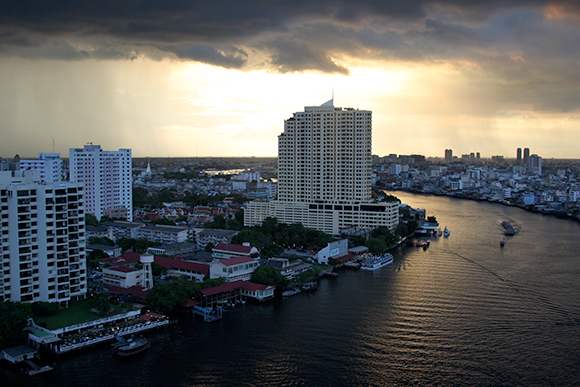
The view of the Chao Praya from our our window as a storm passed overhead. You can’t see them all in this photo, but the Hilton, Shangri-La, Peninsula, and Mandarin Oriental hotels are also located nearby, on the riverbank.
We were still groggy when what sounded like an alarm threw us from our deep, sleepy cocoon at 9.00am. I eventually realised it was the phone, and from what I could tell between the broken English and my not-quite-awake-brain, our tour guide was calling to confirm a pick-up time for our dinner cruise the following evening. I mumbled an “OK, 9.30, see you then” and promptly fell back asleep.
Half an hour later, the phone rang again. The lady was downstairs, waiting for us! I didn’t understand what was going on, but I managed to persuade my boyfriend to roll out of bed and into some clothes, and stumble downstairs with me to meet her. It turns out, she meant 9.30 this morning, not tomorrow night, and the reason for her visit was merely to give us a brief induction on Bangkok, how to travel safe, where to go and what to see. I could get used to this service. (To this day I still don’t know who exactly she was or what company she represented.) We felt terrible for keeping her waiting, but on the bright side, we seemed to have just made breakfast.
Breakfast at the Sheraton Orchid is a multi-faceted experience of the senses. The tiers of pastel cupcakes and glossy pastries catch your eye first – they glisten under the bright buffet lights, like little parcels of joy waiting to melt in your mouth. The bread baskets spill with wholemeal, rye, sourdough, scones, grain, croissants, and plain old white bread, ready for the toasting and a generous slathering of the jams and spreads on display. A rainbow of fruit is fanned out on elegant platters of white. Speckled dragonfruit adorns a plate with paw paw, rockmelon, and mangosteen, while the lychee, rambutan, and pineapple wallow in bowls of syrupy broth.
If that wasn’t enough, the bain-maries of hot food shelter the variety of traditional American breakfast foods you would expect from an international chain – eggs, bacon, hash browns, tomato, mushroom, sausages – and also the variety of traditional Asian breakfast foods you would expect from a hotel rife with Indians and Asians alike – curry, paratha, sambar, rice, and an omelette station that was twin to the noodle station, manned by a chef in a great white hat, where any concoction you can think of was available at your request. It became apparent that being such close neighbours, Thailand must be the “Indian Bali”.

Lulled into a false sense of security, bellies overflowing and believing we were braced against anything Bangkok might throw at us – we strode confidently towards the glass doors of our hotel foyer…
And as quickly as we had summoned up our bravado for the day ahead, we were instantly humbled. The humidity felt like it was at 100% as the heat of central Thailand hit us like an invisible force field. This was no heat that we had endured before, not even in the open fields of Nara’s deer park in Japan’s late summer. This was the suffocating, stifling fever of a landlocked city situated too close to the equator for comfort. As we crawled towards the (luckily, conveniently located) dock alongside the hotel, we were propositioned by at least a dozen taxi drivers in the 30 seconds it took to reach the ticket booth. Shaken by our first encounter with Bangkok’s touts, and dripping with sweat already, I perched myself on the hot, stone seats of the ferry wharf and snapped photos to kill time.
The ferry costs between 11 – 40 baht per trip, which at the time cost us no more than AU $1.30, a bargain! You’ll see everything from monks to schoolkids to men on their commute to work on the ferry. I suggest you sneak at least one ride into your Bangkok trip, even if you’re not staying on the river. The only thing to look out for is being overcharged. Buy your ticket beforehand at the ticket booth, rather than waiting until you are on-board. We were charged 200 baht in one instance for a trip we had taken several times previously, so we knew we getting scammed when the female ticket seller inflated the price 5-fold and then pocketed the coins herself!
We disembarked near the Grand Palace, and stepped off the ferry straight into a marketplace. Now, I’ve navigated my way through conversation with Finns under the midnight sun; that unique, alien dialect unlike any other in this world, and yet still, that common Thai street scene was more foreign than either of us have ever experienced. The unwavering, relentless heat, the smell of dried fish, the shout of young boys selling ice-y fruit drinks, the sizzle of skewered chicken and pork.
By the time we reached the Grand Palace, we were overloaded with the sights, smells, and sounds of this suburban bazaar. Sadly, the palace was closed due the riots, but we enlisted the services of a friendly-looking tuk-tuk driver to show us what sights were open.
Our first stop was Wat Pho, Temple of the Reclining Buddha.
I found it fascinating that there were exactly 108 bronze bowls lining the wall for devotees to offer coins in exchange for prayers of good fortune. The 108 bowls are symbolic of the 108 characters of Bhudda – a number that reminds me of my own childhood, being encouraged by my mother to recite my Hindu payers 108 times, counting with the japa mala (rosary beads) she had given me. (I believe there are similar associations with the number 108 in other religions, for example, there are said to be 108 incarnations of the Hindu God, and some Christian denominations have 108 beads on their rosaries.)
Apart from the magnificent bhudda, the temple is known as being the first public university in the country, having scriptures in the fields of religion, literature and science engraved in plaques around the complex. Because of these plaques, it is also home to one of the first Thai massage schools, held in the open courtyard. The school also offers massages from 8am – 6pm daily, at a fee of 250 – 400 baht.
People often say when travelling Europe, “if you’ve seen one cathedral, you’ve seen them all!”. Whilst I disagree with that mentality, I have to admit the beautiful temple buildings soon became gaudily ornate in my eyes, with their gilded statues and spindly chedi’s (pyramid-shaped mounds) decorated in a mosaic of brightly-coloured tiles. Where at first we were breath-taken, soon we were jaded, as each turned corner revealed much of the same.
The Temple of the Reclining Buddha is open from 8.00 – 5.00pm daily, with an entrance fee of 100 baht.
Our second destination was closer to the city. As our driver navigated the hauntingly empty streets of inner Bangkok we couldn’t help but notice the tourists had all fled in the wake of the riots, which – while unnerving – boded well for us. Our tuk-tuk putted quickly past queues of heavily-armed guards, a hedge of military green framing the state buildings.
Wat Benchamabophit, or the Marble Temple, was empty, except for what seemed to be a theological lecture occurring in the front lawns. We were hesitant to enter, but the doors were open and the attendants quite happy to take our money. Our driver promised to wait for our return – another post-riot bonus we were glad to take advantage of!
While still gilded in the usual Thai style, this temple was unusually zen, evoking the same calm from the abandoned city. For a moment it felt like I was back in Kyoto, bathing in the serenity of Kennin-ji temple. A handful of worshippers knelt inside before oscillating fans, bowing to a giant, golden buddha. We paid our respects and found an exit to the side of the shrine, at which point a sprawling plain of white marble presented itself. The fresh air was welcoming after the still, incense-thick air of the temple room, but it was hot, and the gleaming marble was blinding in the late afternoon sun.

The temple was commissioned by King Chulalongkorn, although you may know him better as the child prince in the movie and stage production, “The King and I”. This temple celebrates the revolutionary achievements the King made for his country: from massive educational reforms, to securing the Northern borders against invasion colonisation, and most importantly, abolishing slavery. It’s no wonder he is Siam’s most loved King! His ashes are now buried beneath the golden Buddha.
Tentatively, we put a foot down, testing the waters. The marble tiles were white-hot, and there was no way across except straight through the middle. We decided to make a dash for it; by the time we reached the other side of the courtyard, our bare feet were scorched and sore. We collapsed in a couple of old steel chairs in a pile of sweat and smiles despite the insanity of the heat, the metal cool relief against our skin.

Another European influence, this sea of white marble was sourced from Italy – traded for spices perhaps?
There was silence in the temple grounds, except for the flutter of a transient sparrow. I wondered what it would be like on a busy day; would the courtyard be packing with kneeling devotees, praying under the resounding booms of a drum or brass gong? A bunch of long-stemmed roses rested on a nearby bench, blood-red against the marble. We buried our noses in its delicate, candy-sweet bouquet, and thought of the blood that would have been spilled just days ago, not far from here.
War had been raging outside these temple walls, and it was inevitable that we face up to it. Whilst there was still a strict night time curfew, the central city was now open during daylight hours, and our driver took us to one last stop.
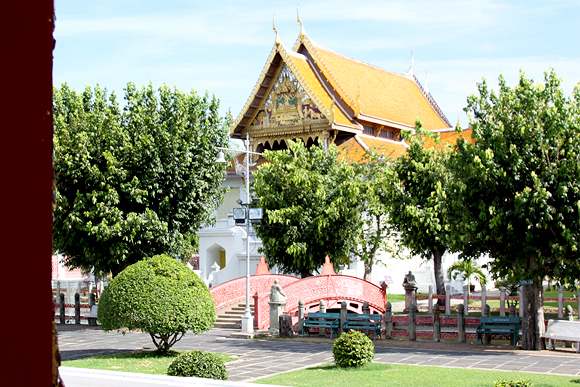
A ‘Sala Nam’ (water pavilion) and Monks quarters to the side of the temple is a quiet, and pretty enclave. Make sure you don’t miss it if you visit the temple!

Almost Amsterdam-like (but prettier!) are these series of little bridges connecting the Temple and the Monks quarters.
The Marble Temple is open from 8am- 5pm daily, with an entrance fee of 20 baht.
In central Bangkok, buildings had been torn open by the raging claws of war. An exposed escalator was charred and black, a set of ATMs blown apart from a grenade. Crowds of people flock to the damage; the newest, starring attraction. Tourists posed in front of the burnt remains. Vendors selling grilled chicken and pork sticks took advantage of the crowd, trying to make an honest dime, regardless of the occasion. I was born in a war-torn country, but still this scene paralysed me. The reality of it could not be escaped; one can just image the screams of civilians, the deafening pound of bullets into concrete, the bomb blasts and the lingering ringing in your ears once it was all over; a souvenir for the bloodshed. The smell of smoke was still upon the air…
By the end of the conflict, 52 people were dead, and more than 200 injured.
On the way back to the wharf, we encountered the cacophony of peak hour traffic. Stuck right in the middle of an intersection, with angry taxis and towering buses honking all around us, I took a moment to reflect on the surreal situation – like a TV advertisement for “Tourism Thailand”. I could smell the fumes of old vehicles, putting their way across the road like a crippled grandmother. Family’s on scooters zipped through the maze of cars, deftly making their way home for dinner. We would revisit this traffic later in our travels, en-route (and very late) to our plane home, but more on that another time.

A kodak moment whilst stuck in traffic. (OK, I admit this is a great shot my boyfriend took, but I had to drop it in somewhere!)
When our driver eventually dropped us off we were sad to say goodbye, but we tipped him 30 baht (the equivalent of AU$1), hopefully enough for a good meal. He thanked us with his hands pressed together in the universal sign of gratitude and a smile I will never forget.
Like this post? Leave a comment to let me know! I’ll be writing more on Thailand soon, including the Bangkok floating markets, Chiang Mai and the Golden Triangle, Phang Nga Bay and Paradise Resort, and a Wedding and Wilderness in Koh Samui.


